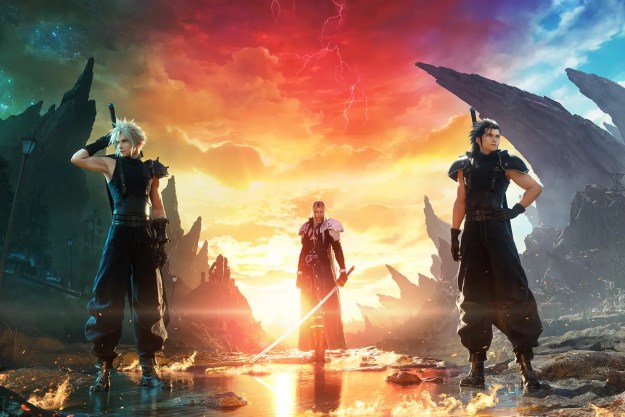Dissidia Final Fantasy NT isn’t here to make new friends. Square Enix’ competitive action-fighter tweaks the spinoff series’ bizarre mix of action role-playing and fighting game mechanics, with dozens of variables that can determine the outcome of a battle. While it aims to please, featuring a narrative that brings together characters from the original Final Fantasy all the way through Final Fantasy XV, Dissidia makes little effort to make newcomers feel welcome.
For Final Fantasy die-hards, its “worlds collide” story and famous battle locations will serve up plenty of FF fan service. For everyone else, Dissidia is an obtuse fighting game that doesn’t care to teach you its quirks.
The long road to success
As with the previous two Dissidia games, Dissidia Final Fantasy NT is a competitive fighter that draws elements from hack-and-slash action games more than the series’, role-playing roots. A “standard” three-on-three match tasks each team with defeating a trio of opponents by draining their hit points (“HP”). That sounds simple enough, but Dissidia forces you fight in a very specific way, which will be foreign to almost everyone.
Normal attacks, which drain HP, are initially ineffective. Instead, you must whittle down their “bravery,” a second stat that serves as a defensive buffer. Before busting out normal attacks, you must use your light attack, which the game refers to as a “bravery attack,” to deplete their bravery and bolster your own.
The system, again, pushes you to fight in a very specific style — long combo strings using a flurry of bravery attacks, capped with a heavy hitting HP attack. The damage you eventually deal with an HP attack is determined by the disparity between your bravery and your opponent’s, so you want to hit them with as many quick attacks as you can before going in for the kill. At the same time, if you hit an enemy with a long bravery combo, but fail to land an HP attack, your enemy will take no lasting damage.
For longtime Final Fantasy players, Dissidia NT’s “worlds collide” story is just what you’re looking for.
While it isn’t exactly what most people have come to expect when they think about fighting games, the system makes for more strategic combat than we’ve seen in other hack-and-slash-inspired fighting games. And when you eventually land a finishing blow, your success is both relieving and exciting.
Dissidia’s systems are interesting, but only if you’re willing to train (and suffer) as you figure them out. While the game features tutorials that outline the game’s core systems, those tools fail to adequately prepare you for battle. There’s little explanation of team composition or individual character skills. Picking characters who complement each other is very important: Cloud Strife plays drastically differently than Firion from Final Fantasy II, and knowing the distinction is important whether you’re playing solo with AI teammates, or online with other players at your side.
Finalest Fantasy
In a similar fashion to the universe-melding Subspace Emissary mode from Super Smash Bros. Brawl, Dissidia Final Fantasy NT’s story sees heroes and villains from nearly every main Final Fantasy game transported to a mysterious world by the goddess Materia. Engaging in an all-out conflict to save her realm from the “void” and her chaotic enemy Spiritus, she requires the energy generated from your battles to keep the world alive.
In practice, it’s a quick narrative device to explain away why Tidus from Final Fantasy X would enter the world of Final Fantasy VI, and famous villains like Kefka Palazzo and Ultimecia are always just around the corner. The villains never get too menacing, particularly when sassy rhyme master Shantotto is around to stall them, and the heroes only need a few minutes of screentime for their virtues to shine. It’s a blast to see so many of Final Fantasy’s famous faces together, even if the mystique surrounding some of the 8 and 16-bit characters is lost when you see them in a highly-detailed 3D model.
The rate you level up at is far behind the rate at which you complete sections of the campaign so you’ll have to grind more just to hear a few more conversations.
The battles in the story mode are fair and evenly spread out, but the game imposes a bizarre gate system for each area. New sections – battles and cutscenes – require spending “Memoria,” an in-game currency acquired through leveling up your profile. The rate at which you level up lags far behind the rate at which you complete sections of the campaign, so you’ll inevitably have to grind more experience (and Memoria) by playing the arcade “Gauntlet” or head online, just to hear a few more conversations.
Dissidia Final Fantasy NT is unlikely to win over many new players, but for longtime fans looking for the next chance to wail on the Onion Knight or Squall Leonheart, it does the job. Should its multiplayer community stay alive, it’ll offer a nice change of pace from those used to traditional 2D fighting games. Maddening tertiary characters aside, it offers some old-school Square Enix charm, and its depth makes it feel like a game from a different era. It won’t be everyone’s cup of tea, but, like we said, Dissidia isn’t here to make friends.
Editors' Recommendations
- Tribeca Games 2024 will feature 7 games and a Final Fantasy 7 panel
- Final Fantasy 7 Rebirth: all piano sheet music locations and rewards
- The best ways to farm Gil in Final Fantasy 7 Rebirth
- The best armor in Final Fantasy 7: Rebirth
- Final Fantasy 7 Rebirth preload guide: release time, file size, and preorder






